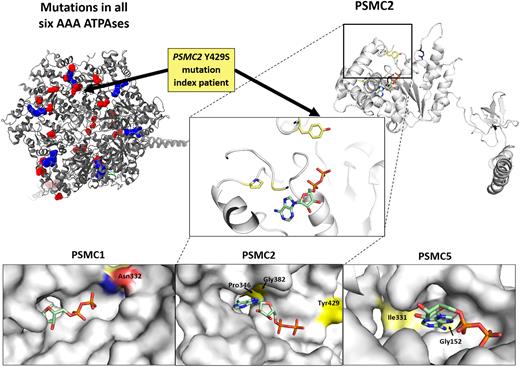Abstract
Background For the treatment of Multiple Myeloma (MM), proteasome inhibitors (PIs) are highly efficient and widely used, but resistance is a major obstacle to successful therapy. Several underlying mechanisms have been proposed but were only reported for a minority of resistant patients e.g., mutations in the PI binding domain PSMB5. However, the proteasome is a large and complex machinery and its mechanistic understanding remains incomplete. In this study, we unravel the role of the six ATPases of the 19S proteasome regulator (PSMC1-6) in MM resistance.
Methods As an example of cancer evolution and the acquisition of PI resistance, we conducted an in-depth analysis of an index patient applying deep sequencing of immunoglobulin rearrangements (IG), FISH, and WES in serial samples at MGUS, newly diagnosed MM, and five later timepoints including two relapses. Then we expand towards generic meta-analyses of PSMC alterations in our own and other published datasets comprising 1,499 newly diagnosed (NDMM) and 447 PI pretreated MM (PMM) patients for WGS/WES. For RNA sequencing, we analyzed 16 normal plasma cells (NPCs) and 360 NDMM patients. Furthermore, we explore the structural impact of PSMC single nucleotide variants on the proteasome and their relevance for PI resistance using 3D modeling with Chimera and Pymol.
Results The WES analysis of our index patient uncovers a PSMC2 Y429S mutation acquired at the second relapse after intensive bortezomib-containing therapy. We functionally confirm this variant to mediate PI resistance in the cell line RPMI 8226. In the meta-analysis, a total of 36 mutations were identified (mutation incidence: 1.85%). The PSMC5 G152S mutation was found in three independent patients, and a G152R in a fourth patient, thus, representing a potential hotspot. Based on 3D structural projections, the identified mutations can be clustered into three main groups: first, mutations affecting the intrinsic conformation of the respective subunit; second, mutations perturbing the PSMC protomer interactions and the proper folding/functioning of the whole complex; and third, mutations impairing the ADP/ATP binding pocket (Figure). Nine mutations belong to the third category interacting with the adenine ring or the phosphate groups of the ATP. The expression analysis reveals a significant upregulation of PSMC3 (P=0.003), PSMC4 (P≤0.001), and PSMC5 (P=0.043) from NPC to NDMM.
Conclusions The 19S hexameric AAA ATPase ring of the 26S proteasome is responsible for unfolding and introducing the substrates into the catalytic 20S complex. PSMC gene alterations are structurally often located in regulatory sites for activity e.g. impacting the ADP/ATP binding pocket. The following activation of the 26S proteasome increases the PI tolerance and represents a new PI resistance mechanism. Moreover, changes in the expression level of the PSMC members seem to play a role not only in the development of PI resistance but already in the development of MM, probably by increasing the protein turnover capacity of myeloma cells. This study opens the way to explore new classes of proteasome inhibitors avoiding this kind of mechanism of resistance.
Figure:Mutations in the'PSMC' subunits of the 19S Base AAA-ATPase hexamer accumulate in proximity to the ATP/ADP binding pockets. The backbone of the PSMC hexamer is displayed as a ribbon diagram, mutations (red) and ADP (blue) as 3D spheres (PDB 5GJR). The mutations cluster in areas responsible for proper folding and functioning of the complex or in proximity to the ADP/ATP binding pockets, exemplarily shown for PSMC1, PSMC2, and PSMC5. ADP is presented as a wireframe stick in light green (PDB 5GJQ). The PSMC2Y429S mutation of the index patient is indicated in yellow.
Disclosures
Munshi:Amgen: Consultancy; Janssen: Consultancy; Bristol-Myers Squibb: Consultancy; Takeda Oncology: Consultancy; GSK: Consultancy; Oncopep: Consultancy, Current equity holder in publicly-traded company, Other: scientific founder, Patents & Royalties; Novartis: Consultancy; Adaptive Biotechnology: Consultancy; Pfizer: Consultancy; Abbvie: Consultancy; Legend: Consultancy; Celgene: Consultancy; Karyopharm: Consultancy. Barrio:Altum Sequencing Co.: Current Employment, Current equity holder in private company. Martinez-Lopez:Altum Sequencing Co.: Current equity holder in private company.
Author notes
Asterisk with author names denotes non-ASH members.


This feature is available to Subscribers Only
Sign In or Create an Account Close Modal